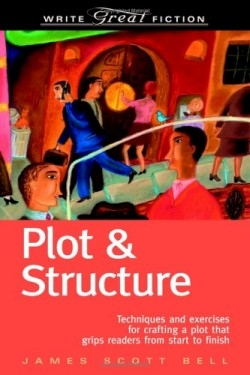Write Great Fiction
Plot and Structure
The Big Lie. Its what keeps many would-be writers away from their computers and sends many first-time writers away from their screens in despair. What is the big lie? The idea that writing cant be taught.
The author debunks this idea in this how-to guide, which teaches the art of plot and structure in understandable terms with extensive use of examples from literature and film. A former trial lawyer, Bell is the best-selling, award-winning author of several novels including Final Witness and City of Angels as well as the Shannon Saga series, and frequently speaks at writing conferences. He is also a thriller writer and columnist for Writers Digest magazine. Here, he introduces what he calls the LOCK system for creating plots: Lead character, Objective, Confrontation, and Knockout ending. He illustrates this system by sharing a story written by his four-year-old son: “Robin Hood went riding. A bad guy came. They fought. He won.”
Keeping the LOCK system in mind, Bell goes on to address each point of plot, from creating ideas to writing catchy beginnings, action-packed middles, and unpredictable endings. Then he digs into the how-to by introducing plotting systems that work for a range of writers, from those who equate outlining with sticking themselves in the creative eye with a lit match to those who wouldn’t dream of starting a novel without first mapping out every detail on color-coded index cards. For example, the Headlights System works by outlining as the story unfolds. Like driving at night with only part of the road illuminated by the headlights, this system outlines only as far as the author can immediately see. Having written to that point, the writer then outlines the next small section.
As all good guides do, Bells offers a chapter on common problems with suggestions for fixing them. For example, if a scene is falling flat, Bell suggests finding the point where the intensity is greatest, then working backwards from there to see if any earlier material can be cut. Deleting unessential information will take the reader to the action faster, so interest doesn’t have time to lag.
Exercises are offered at the end of each chapter that will help both aspiring writers and those with a rough draft already in their clutches. Readers should be prepared to work, however. “Just reading a book on plotting is not going to make you a better writer,” Bell warns. “You have to try out what you learn, see if you get it, and try some more. You test the principles in the fire of the blank page.”
Reviewed by
Christine Canfield
Disclosure: This article is not an endorsement, but a review. The publisher of this book provided free copies of the book to have their book reviewed by a professional reviewer. No fee was paid by the publisher for this review. Foreword Reviews only recommends books that we love. Foreword Magazine, Inc. is disclosing this in accordance with the Federal Trade Commission’s 16 CFR, Part 255.

